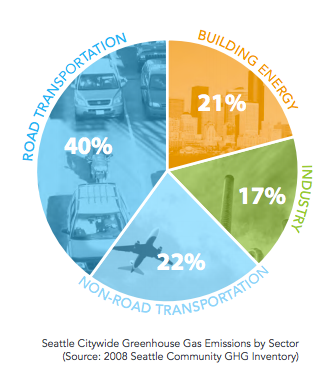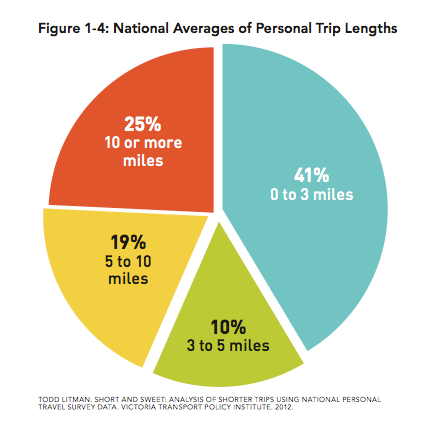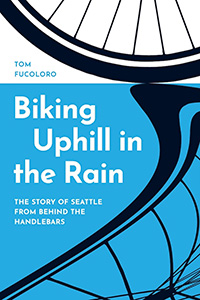
 One problem with Earth Day and many conversations about climate change is that by putting the issue on a global scale, the problem can become overwhelming. You read about ever-increasing global temperatures and our still-increasing global carbon emissions, and your personal impact feels so insignificant that hopelessness sets in.
One problem with Earth Day and many conversations about climate change is that by putting the issue on a global scale, the problem can become overwhelming. You read about ever-increasing global temperatures and our still-increasing global carbon emissions, and your personal impact feels so insignificant that hopelessness sets in.
There are lots and lots of causes of climate change that are beyond my expertise and the scope of this blog. But transportation makes up a huge percentage of greenhouse gas emissions. Seattle Neighborhood Greenways posted two graphs today that help to shrink the scale of the problem to a still-large, but more manageable level.
In Seattle, 40 percent of greenhouse gas emissions come from road transportation (“non-road transportation” emits another 22 percent). Walking and biking can’t reasonably offset the entire 40 percent, but it can easily and quickly reduce it.
For example, 41 percent of all trips made in Seattle are three miles or less. Most people are physically able to bike three miles with ease, and many of the trips are an easy walk. Half of trips in Seattle are fewer than five miles. These trips are the lowest-hanging fruit in reducing carbon-emitting transportation choices.
But climate change is a complicated reason for advocating for more biking and safer streets. On a governmental, system-wide level, climate change is one of many great reasons to institute policies that prioritize walking, biking and transit when making transportation investments.
But on a person-to-person level, the same arguments are not always as effective. When people phrase climate change as the result or fault of a person’s individual everyday choices, they draw a somewhat expected backlash. It is a bit smug to tell another person (especially a stranger) how they should (legally) live their life or that their car is the cause of global climate change.
If climate change motivates you to ride a bike, that’s great (it motivates me). I like bikes a lot and think they are a great emissions-free way to get around, but even I cringe when someone says they’re “saving the planet” by riding their bike and that people who drive are “part of the problem.”
Nobody drives a car because they hate the planet. When asked why people don’t bike, the most common answer is that they are concerned about safety. Most Seattle residents want to bike more than they do today. When streets are made safer, people discover that bikes are a convenient, fast and easy way to get around. So instead of motivating change through guilt (a method with a rather poor success rate), we should fix our communities so they are no longer engineered so disproportionately toward driving for even simple trips. When people have real transportation choices, most people will only choose cars for trips that truly need a car.
Will this solve global climate change? Of course not. But it’s a big bite out of Seattle’s total greenhouse gas emissions, and it will make our city and neighborhoods a lot safer and more vibrant in the process.












Comments
24 responses to “40% of Seattle’s greenhouse gas emissions are from road transportation, and 41% of trips are under 3 miles”
nicely said!
[…] – 40% of Seattle’s greenhouse gas emissions are from road transportation, and 41% of trips are under… […]
Why drive for a trip of less than 3 miles?
Because when I drive, I don’t have to change my clothes from street clothes to bike clothes. If it’s raining, I get wet for maybe 1 minute, so I don’t have to dry off on either end of the trip.
If I have 30lbs of groceries, they fit in the back of my car with ease, no repacking to make it fit in my panniers.
If my family comes with me, we all ride together in one car.
What would get me to change my mind?… no parking for the car. OR high price for parking. And covered parking for my bike where I don’t have to worry about it being stripped of parts while I’m shopping.
Otherwise, this pretty much explains why people drive vs bike to the store.
That said, I’m working on fixing the those issues. In the long run I’m getting a good cargo bike just for these trips. I’ve bought knickers that I can wear around the house and to the store…
I won’t argue with the getting wet part. But I carry up to 50 lbs of groceries relatively easily on my normal, non-cargo bike, and bike-specific clothes are completely optional.
Agreed.. a set of panniers in back and a basket in front will carry an unbelievable amount of stuff. And no repacking required if you bring the panniers in the store with you and bag directly into them at checkout. And changing into “bike clothes” to go to the store? Huh?
Interestingly, I rode about 2.5 miles to a better/faster bus stop this morning (normally when I bus I use two; instead I just biked directly to the last leg). Boxers and slacks, no bike gear other than helmet – and I was perfectly comfortable. I’ll wear bike shorts when making a full commute, but they’re really not necessary for such short distances; even in the summer I wouldn’t expect to build up a sweat unless there’s a major climb or I’m going more than just 2-3 miles.
There are lots of solutions to groceries that don’t require a car too. This doesn’t work for everyone, but my wife or I will stop at the grocery store several times a week and pick up incremental stuff instead of making one big trip, then just walk the rest of the way home (~1 mile). Also, you’d be surprised how much you can fit in a set of panniers :) . Cargo bike does give you a big leap in flexibility though!
I do think available secure bike parking would be great. I’d love to see a system where all you needed was a normal combo/pad lock. The rest of the locking system will be in place. That addresses the bike part, but as you note bikes are commonly stripped of components and accessories.
I commute daily all year long. I’ve got the panniers (they get pretty grimy in the winter months). I’ve got the “bike gear” and it’s a lot nicer to wear than my street clothes for even the 3 mile ride to the store than jeans and coat… Yes I can haul 50 lbs of gear in those bags but I hate it. 30 is about my limit. Yes I have gone to Costco and strapped everything all over the bike for the 14 mile round trip. Didn’t take that long either but the point of the article is: “Why do people drive a 3 mile trip?”
And my answer is “It’s way easy, if you a) own a car. b) are bringing someone else, c) are making more than one stop, d) it’s raining or cold etc… , e) parking is free and easy on both ends.”
I used to live where parking was costly and tight even if I wanted to pay for it, so I walked to the store regularly. Make people pay real money for parking everywhere and you’ll increase bike ridership on these trips.
Otherwise, human’s are tool users and lazy. Cars fit that bill to a “T”
I get your point, Gary. It’s especially pertinent in parts of the city and region that were built (or re-engineered) around the assumption that people will drive everywhere. I grew up in such a neighborhood in St Louis, and we drove everywhere. It honestly never crossed our minds to get around any other way, even though in retrospect the grocery store really was not very far away. I totally get why people don’t bike every trip, even those under 3 or 5 miles.
There are many areas in Seattle that are already dense enough that necessary destinations are within reach and driving is no longer convenient (simply too many things happening for everyone to drive there). For these areas, the biggest missing piece is a comfortable space to bike.
For more sprawled out parts of the city and especially around the region, the built environment is so car-centered that there is a lot more work to do than just complete streets (though complete streets would go a long way).
But if we can’t even complete the lowest-hanging fruit — those areas already built and ready for safe and comfortable bike lanes — then how are we going to even start on the areas that need more dramatic work?
I think Tom’s focus is right on, here. It’s about the incentives people have and the infrastructure that’s there — people will optimize around these. I grew up in the Chicago suburbs, less than a mile from a grocery store that I practically never walked to maybe until I was in High School. There are even sidewalks all the way there and around the shopping center complex, and the store was on the near side of that… it’s not even like walking there from my house was all that hard. But it was near a really huge highway intersection (one of the 10 most dangerous in Illinois!) and the complex was basically a super-sized strip mall — driving is the default by design and behavior follows. If I had to run a quick errand and couldn’t drive (if I was too young, or if the car wasn’t home) I’d walk to a nearby convenience store, which was hardly any closer (and generally a little more expensive) but felt much closer — it faced the street, and the street was a little smaller and a lot slower.
(I actually had to look up the distances — it’s 0.6 miles to the big grocery store, which shocked me, I could have sworn it was longer. The convenience store is 0.5 miles away. Actually, before the big store’
(oops, fat-fingered “tab”…)
… before the big store’s complex was redesigned maybe 15 years ago the big store was almost exactly as close to my house as the convenience store. But the convenience store unquestionably felt closer. I was truly surprised just now to find it wasn’t twice as close.)
Okay, I’m going to say it. You can bike in jeans. It is fine. They really don’t chaffe like people claim, and it is not uncomfortable in the least. On a hot day I’d pick something else, but then I’d pick something else for walking around too.
The worst thing about biking in jeans is if you do it all the time you tend to wear the butt out quicker than if you didn’t.
In parts of the country where it’s genuinely cold in the winter, nobody complains that they have to put on an overcoat while walking out to the parking lot.
If you’re only biking a mile, or three, you don’t need to change clothes, just have a bike with fenders and a chain guard, put on an overcoat, and ride an easy pace to avoid getting sweaty. (2 miles @ 10mph = 12 non-sweaty minutes.)
Of course the choice of driving is made even more likely due to the subsidy we as a society have given to that choice.
This is the arrangement I use to haul groceries for long distances – pretty waterproof, too:
http://www.completek-12.com/Deluxe-Hooded-Grocery-Cart-Liner-p/folding-cart-liner-dhgcl227.htm
Works fine for hills, too.
Great solution for carrying stuff with or without your bike is the award winning Burley Travoy http://www.modernbike.com/burley-travoy-cargo-trailer-yellow
I had to get a rack adapter for it, and it’s pricey, but in 4 years I have saved much more than that in gas. It is rated for 60 lbs though I have hauled heavier loads and bulky items including bags of compost, golf clubs, yoga mat, small cooler and grill for picnics and big grocery loads. It tracks beautifully behind the bike but also pops off it’s pin in seconds and serves as a hand cart that goes on the bus, in the store and folds down and fits into its own bag small enough to put in an airplane carryon compartment.
Bike from Northgate to UWMC? Yikes! On the flat it would be easy, but those hills? I’d be a soggy sweaty mess by the time I reached either destination! :P
Why drive? Well, if you happen to have a medical condition that affects your balance, you must. Not everyone who drives is bad, you know. That’s the underlying sense of this blog- cars=bad, bikes=good. One day you may be in the same boat, so keep that in mind.
I think if you read more posts, you’ll see that’s not true. For example, here’s one I posted directly before this one: http://www.seattlebikeblog.com/2014/04/22/traffic-violence-is-not-a-war-its-a-horrifying-disease/
Cars themselves and cities engineered entirely around cars are problematic, but I would never suggest that people who drive cars are bad. Just like I wouldn’t suggest that people who bike are good people. People are people making choices that makes sense for them in their unique situations.
In many places, cars are the only reasonable choice due to a lack of options and the way places were built. That’s a serious problem, and one that we created. And because we created it, we can fix it. People want more choices for how they get around, and will use them once we make them possible and appealing.
In the aggregate, people make transportation choices based on personal preference and economics – only a few do so to save the planet.
As long as we hold fossil fuel prices to an unnaturally low level, people will drive more than they should in vehicles that pollute far more than neccessary. If our fuel tax was high enough to truly pay for the roads and to compensate society properly for the pollution and natural resource depletion, people would optimize to more walking, biking, ride-sharing, and efficient vehicles.
Now, I have to jump in my V8-powered car and drive the two miles home from Starbucks.
“Will this solve global climate change? Of course not.”
I was reminded of this comic:
https://d3n8a8pro7vhmx.cloudfront.net/foe/pages/318/attachments/original/1484021930/global-warming-hoax.jpg?1484021930
Imagine how horrible it would be if we made Seattle an incredible place to walk, bike, and live.. and it wasn’t the major factor in solving climate change. Oh, how miserable we’d be.. :)
Well said, Tom.
And, we are blessed with a very mild, if damp, climate. It is totally possible to dress for going from place to place to place without succumbing to the recreational industry’s marketing of different clothing and gear for every different thing we do. With some rain gear that fits over other clothing for cool wet weather, and quick drying normal clothing for warm wet weather, and flat pedals for boots, sneakers, dress shoes and sandals, there is no need to change at the start and finish of every ride.